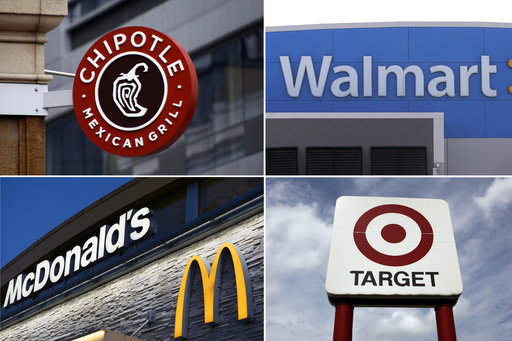Value shopping emerged as a dominant trend in 2024, influencing how consumers spent their money amidst rising costs for housing and groceries. U.S. shoppers became selective with their purchases, leading many affluent patrons to shift their shopping habits toward discount retailers like Walmart and Aldi. This trend also extended to dining, where more customers preferred fast food or home-cooked meals over traditional sit-down restaurants. Meanwhile, department stores faced challenges as consumers increasingly favored online shopping or opted for budget-friendly retailers such as H&M. Additionally, significant changes were observed in home decor spending, as people moved away from high-ticket items like furniture and renovations, choosing more affordable decorative elements instead.
These consumer behavior shifts had a substantial impact on retail and dining sectors by the end of the year. According to research released by Coresight, the number of retail bankruptcies in the U.S. surged to 48, compared to 25 in the previous year during the same timeframe. The restaurant industry faced similar troubles, with at least 22 chains filing for bankruptcy—the highest figure recorded since 2020. Below are prominent trends and notable outcomes observed throughout 2024:
**Winners:**
**Walmart**
Walmart thrived in the challenging economic climate, as it tends to do in such situations. The retail giant saw its customer base grow, particularly among households earning above $100,000, due to its affordability, particularly in groceries, which make up 60% of its revenue. Walmart’s efforts to enhance its online services and introduce more fashionable clothing lines also seem to attract this demographic, solidifying its customer retention strategies.
**Amazon**
Amazon further solidified its position as a go-to destination for value seekers. In November, the company unveiled Amazon Haul, a new platform featuring products under $20. Record sales were recorded during its July Prime Day, but potential challenges loom for the online retail giant in the upcoming year due to possible tariffs on Chinese imports and labor disputes in the U.S.
**Fast Casual Chains**
Restaurant chains that fall under the fast-casual category, like Shake Shack, enjoyed success as they provide customers with good value while stepping up from traditional fast food. Cava, a Mediterranean restaurant chain, reported a revenue increase of over 33% in the first nine months, partially due to aggressive expansion. Chipotle faced some criticism for smaller portions but worked to retain customers by improving consistency and quantity.
**Jeans Retailers**
The resurgence of wide-leg jeans created a sales boom across various retailers. Brands like Macy’s, Abercrombie & Fitch, and Levi Strauss reported positive impacts from this shift. Value shoppers even found affordably priced options at Walmart for around $29, while luxury brands like Gucci offered their versions at up to $1,200.
**McDonald’s**
Though McDonald’s initially struggled with a dip in sales, a $5 meal deal introduced in June successfully drew back budget-conscious customers. This promotion was extended until year-end, with more value choices promising in 2025, following a health scare related to E. coli linked to the Quarter Pounder.
**Losers:**
**Target**
Target saw a decline in popularity, largely due to its reliance on discretionary spending, as food items represent a small fraction of its sales. The retail chain struggled with perceptions of higher pricing, and many customers noted disorganization within its merchandise assortments. Nonetheless, Target attracted crowds for its exclusive Taylor Swift merchandise on Black Friday.
**Starbucks**
Challenges mounted for Starbucks this year as complex drink orders resulted in frustrating delays and increased inaccuracies with mobile app pickups. New menu items like olive oil-infused coffee failed to capture consumer interest, and rising prices deterred some customers. The appointment of new CEO Brian Niccol aims to address these obstacles, yet ongoing labor disputes might continue to pose issues.
**Legacy Restaurants**
Well-established restaurant chains like Red Lobster, TGI Fridays, and Buca di Beppo faced insurmountable competition and filed for Chapter 11 bankruptcy, leading to numerous closures. While Red Lobster successfully emerged from bankruptcy with new ownership, the future of other aging chains remains uncertain regarding their ability to recover from consistent sales declines.
**Big Ticket Items**
Consumer spending on high-value purchases dwindled in 2024 after a surge during the pandemic. Retailers like Best Buy noted reduced sales in appliances and entertainment equipment, while home improvement giants like Home Depot and Lowe’s also experienced declines in high-end remodeling segments.
**Department Stores**
Department stores catering to middle-income shoppers continued to struggle with retaining customers who favored online shopping or fast-fashion alternatives. For instance, Kohl’s reported its eleventh consecutive quarter of sales drops, prompting its outgoing CEO to admit to merchandise missteps. Macy’s announced plans to close 150 stores while launching a few upscale Bloomingdale’s locations. However, Nordstrom experienced better-than-anticipated results thanks to strong sales from its Nordstrom Rack outlets, and it recently agreed to be taken private, allowing for potential strategic breathing room in a competitive retail environment.



